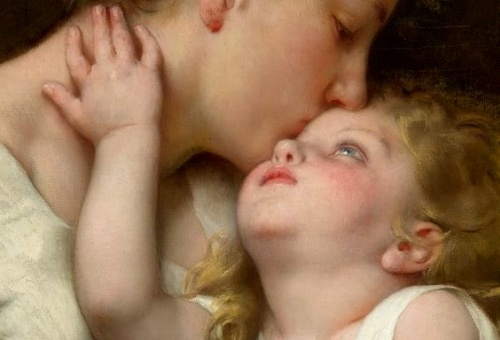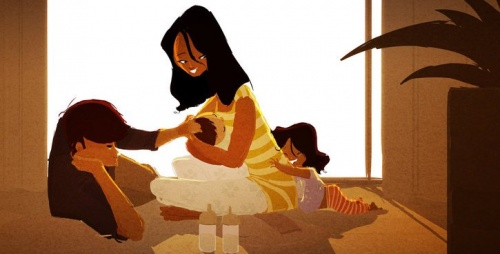Hugging and Comforting Is Not Spoiling, But Educating


Written and verified by the psychologist Valeria Sabater
Spoiling has nothing to do with comforting your child, attending to his needs, soothing his fears or nourishing him with hugs and caresses. Parents who raise their children poorly are those who ignore and abandon them, who make the mistake of thinking that the mind of a baby is like that of an adult who understands manipulation or blackmail.
In an interesting study on affective intelligence, it was shown that most babies experience psychological pain throughout the day, much more so than physical pain. This is undoubtedly worth taking into account: the emotional suffering of children has to do with factors such as hunger, fear or insecurity.
These are instinctive factors that signal an authentic discomfort, and this is something that each child will demonstrate in a particular way, different from that of other children. For that reason, as mothers we have to understand the particular reality of each child, and know that tending to their needs does not mean spoiling them.
We invite you to delve into this topic, which sometimes arouses controversy.
Consoling: the art of understanding needs
If a friend of ours cries, we do not let him cry until he runs out of tears. If our partner, our sister or our father cries, we do not leave the room until they stop. Why should we do that to our children?
Consoling is the exceptional art of knowing what someone needs and then deploying the appropriate care strategies to heal their psychological or emotional pains. For this reason, sometimes it is not enough to say, “calm down, you’re fine.”
For a small child, what gives the greatest power of consolation is physical contact and a tone of voice capable of speaking calmly and intimately.

These are small things that generate authentic imprints in the brain of a maturing baby. Any stimulus, as well as lack of stimulus, will determine the baby’s subsequent development.
Let’s see a few more interesting aspects.
The wisdom of good child rearing
Words are important in our language, but sometimes the most popular expressions try to define pathological behaviors when in reality they are only natural processes. It is very possible, for example, that you have also encountered the situation of having to endure the comments of your friends or family when you hold your child in your arms to relieve his crying or anger.
“You’re spoiling him,” they tell us. We remain silent, knowing this is not the case, because we understand that positive reinforcement at the right moment avoids tantrums, reduces stress and makes our children feel more secure to explore their surroundings at their own pace.
- The wisdom of good child rearing is to know the consequences of prolonged and unattended crying. From the neurological point of view, it causes stress. A high level of cortisol, the stress hormone, alters the chemistry of neurotransmitters, intensifying fear and creating a greater need for attention.
- A good caretaker also knows that comforting, embracing and “being present” improves the bond with our children. Our children need this secure attachment throughout their first three years. It is a stage where their vital needs tend to be simple but essential: security, affection, recognition and enjoying enriching stimuli with which to favor neuronal connectivity.
A child who is allowed to cry until he runs out of energy or who doesn’t receive hugs or caresses is a baby who builds a somewhat hostile idea of the world, a scenario in which he will “always be wanting” and living in a world where he feels the need to defend himself, sometimes with anger.
It is not good enough.

Promote emotional development to help your child grow
Emotional education does not start when a child is already competent when communicating, when we have already set rules, marked limits and negotiated rules. An 8-month-old baby who pulls on our hair when he gets angry is a person who seeks to channel his anger and frustration.
- Emotional education begins from the first day we leave our baby in the crib after arriving home from the hospital after giving birth. We cannot forget that the first emotional anchoring begins at birth with that first skin-to-skin contact between the baby and his mother.
- Breastfeeding is a wonderful pillar to continue building this bond, transmitting security, calmness and well-being. Later, the art of consoling in a respectful way will allow you to help your child continue to grow in a safe environment.
- Neglecting negative reactions is not spoiling either. The 2-year-old boy who throws a toy to the ground with rage or who scratches his brother or mother is dealing with an emotion that he does not understand and that he must learn to channel, comprehend and manage.

The task of understanding emotions and working through them requires science and intuition, something that we should never overlook in children just because they are small. The small things of today can be transformed into the giants of tomorrow. Therefore, it is necessary for us to pay attention, feed them with positive emotions and put into practice the art of good child-rearing.
Spoiling has nothing to do with comforting your child, attending to his needs, soothing his fears or nourishing him with hugs and caresses. Parents who raise their children poorly are those who ignore and abandon them, who make the mistake of thinking that the mind of a baby is like that of an adult who understands manipulation or blackmail.
In an interesting study on affective intelligence, it was shown that most babies experience psychological pain throughout the day, much more so than physical pain. This is undoubtedly worth taking into account: the emotional suffering of children has to do with factors such as hunger, fear or insecurity.
These are instinctive factors that signal an authentic discomfort, and this is something that each child will demonstrate in a particular way, different from that of other children. For that reason, as mothers we have to understand the particular reality of each child, and know that tending to their needs does not mean spoiling them.
We invite you to delve into this topic, which sometimes arouses controversy.
Consoling: the art of understanding needs
If a friend of ours cries, we do not let him cry until he runs out of tears. If our partner, our sister or our father cries, we do not leave the room until they stop. Why should we do that to our children?
Consoling is the exceptional art of knowing what someone needs and then deploying the appropriate care strategies to heal their psychological or emotional pains. For this reason, sometimes it is not enough to say, “calm down, you’re fine.”
For a small child, what gives the greatest power of consolation is physical contact and a tone of voice capable of speaking calmly and intimately.

These are small things that generate authentic imprints in the brain of a maturing baby. Any stimulus, as well as lack of stimulus, will determine the baby’s subsequent development.
Let’s see a few more interesting aspects.
The wisdom of good child rearing
Words are important in our language, but sometimes the most popular expressions try to define pathological behaviors when in reality they are only natural processes. It is very possible, for example, that you have also encountered the situation of having to endure the comments of your friends or family when you hold your child in your arms to relieve his crying or anger.
“You’re spoiling him,” they tell us. We remain silent, knowing this is not the case, because we understand that positive reinforcement at the right moment avoids tantrums, reduces stress and makes our children feel more secure to explore their surroundings at their own pace.
- The wisdom of good child rearing is to know the consequences of prolonged and unattended crying. From the neurological point of view, it causes stress. A high level of cortisol, the stress hormone, alters the chemistry of neurotransmitters, intensifying fear and creating a greater need for attention.
- A good caretaker also knows that comforting, embracing and “being present” improves the bond with our children. Our children need this secure attachment throughout their first three years. It is a stage where their vital needs tend to be simple but essential: security, affection, recognition and enjoying enriching stimuli with which to favor neuronal connectivity.
A child who is allowed to cry until he runs out of energy or who doesn’t receive hugs or caresses is a baby who builds a somewhat hostile idea of the world, a scenario in which he will “always be wanting” and living in a world where he feels the need to defend himself, sometimes with anger.
It is not good enough.

Promote emotional development to help your child grow
Emotional education does not start when a child is already competent when communicating, when we have already set rules, marked limits and negotiated rules. An 8-month-old baby who pulls on our hair when he gets angry is a person who seeks to channel his anger and frustration.
- Emotional education begins from the first day we leave our baby in the crib after arriving home from the hospital after giving birth. We cannot forget that the first emotional anchoring begins at birth with that first skin-to-skin contact between the baby and his mother.
- Breastfeeding is a wonderful pillar to continue building this bond, transmitting security, calmness and well-being. Later, the art of consoling in a respectful way will allow you to help your child continue to grow in a safe environment.
- Neglecting negative reactions is not spoiling either. The 2-year-old boy who throws a toy to the ground with rage or who scratches his brother or mother is dealing with an emotion that he does not understand and that he must learn to channel, comprehend and manage.

The task of understanding emotions and working through them requires science and intuition, something that we should never overlook in children just because they are small. The small things of today can be transformed into the giants of tomorrow. Therefore, it is necessary for us to pay attention, feed them with positive emotions and put into practice the art of good child-rearing.
All cited sources were thoroughly reviewed by our team to ensure their quality, reliability, currency, and validity. The bibliography of this article was considered reliable and of academic or scientific accuracy.
- Bowlby, J. (1986). Vínculos afectivos: formación, desarrollo y pérdida. Madrid: Morata.
- Bowlby, J. (1995). Teoría del apego. Lebovici, Weil-HalpernF.
- Garrido-Rojas, L. (2006). Apego, emoción y regulación emocional. Implicaciones para la salud. Revista latinoamericana de psicología, 38(3), 493-507. https://www.redalyc.org/pdf/805/80538304.pdf
- Marrone, M., Diamond, N., Juri, L., & Bleichmar, H. (2001). La teoría del apego: un enfoque actual. Madrid: Psimática.
- Moneta, M. (2003). El Apego. Aspectos clínicos y psicobiológicos de la díada madre-hijo. Santiago: Cuatro Vientos.
This text is provided for informational purposes only and does not replace consultation with a professional. If in doubt, consult your specialist.








